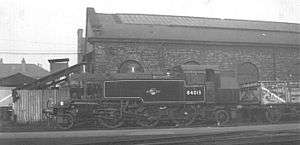BR Standard Class 2 2-6-2T
|
84013 just off the paint shops at Crewe in 1960 | |||||||||||||||||||||||||||||||||||||||||||||||||||
| |||||||||||||||||||||||||||||||||||||||||||||||||||
| |||||||||||||||||||||||||||||||||||||||||||||||||||
| |||||||||||||||||||||||||||||||||||||||||||||||||||
| |||||||||||||||||||||||||||||||||||||||||||||||||||
The British Railways standard class 2 2-6-2T was a class of steam locomotive, one of the standard classes of the 1950s.
Design and construction
The class was designed at Derby Works and introduced in 1953. The design derived from the LMS Ivatt Class 2 2-6-2T which BR had built after nationalisation. Modifications were made to the Ivatt design including a reduced cab to reduce the loading gauge and some standard fittings. BR classified them 2MT, emphasising a mixed-traffic role.
As most services which required 2MT 2-6-2Ts were already served by the 130 Ivatt engines, B.R. only ordered 30 engines, which eliminated pre-grouping steam locomotives as much as possible on local services.
The first 20 engines were outshopped at Crewe Works, and intended for use on ex-London Midland and Scottish Railway routes, then known as the London Midland Region. The second batch, this time built at Darlington Works, were numbered 84020–84029, and intended for Southern Region lines.
Liveries
Only two liveries were carried by the 2MTs- British Railway lined black with the earlier and later emblems. Although all locomotives received the latter, only 84000–84019 received the early emblem as the Darlington built locomotives were constructed in 1957, following the 1956 changeover to the late crest. The Darlington engines carried large 10-inch (25.4 cm) high cab-side numerals, whilst the Crewe engines carried standard 8-inch (20.3 cm) high numerals.
Service
The LMR locomotives were used on push-pull routes, and were often allocated alongside the Ivatt 2MT 2-6-2T engines with which they shared most of their origins. Numbers 84021–84029, the Southern Region locomotives were all allocated to the Eastern Section depot at Ashford for use on the lines over Romney Marsh and local trains on the Margate via Canterbury West route. Most were transferred away to the North Eastern Region in the early 1960s following electrification, but several locomotives (including some of the LMR allocation) were re-allocated to Eastleigh in 1965 for possible use on the Isle of Wight replacing life expired ex-London and South Western railway "O2" 0-4-4T engines, which dated from the turn of the century. However, this did not cover coaching stock replacement, and thus the locomotives were scrapped.
| Year | Quantity in service at start of year | Quantity withdrawn | Locomotive numbers | Notes |
|---|---|---|---|---|
| 1963 | 30 | 1 | 84012 | |
| 1964 | 29 | 9 | 84001/07/20–24/27/29 | |
| 1965 | 20 | 10 | 84000/02–06/08–09/11/18 | |
| 1966 | 10 | 10 | 84010/13–17/19/25–26/28 | |
Preservation
None of the class survived the cutter's torch, although their size and configuration would have made them an ideal choice for use on heritage railways. However, four BR standard class 2 2-6-0 locomotives – the tender-equipped equivalent – did survive, and one of these, 78059, is being rebuilt into 2-6-2T "84030". This takes the next number in the original series. 78059 was chosen primarily because it lost its tender while at Woodham Brothers scrapyard, Barry. Further reasons cited by the Bluebell Railway, where 78059 is based, are the suitability of the locomotive class for the railway's service trains, and because the tender version of the class was never allocated to the Southern Region, and hence the tank version (which was allocated there) is far more appropriate for the Bluebell's Southern Region location. As of 2013, 78059 was considered to no longer exist, as the fitting of the hind engine frame extensions have turned it into 84030. [1] [2]
References
- ↑ "British Railways Standard Class 2MT 2-6-2 Tank Locomotive No 84030". Bluebell Railway. 14 April 2008. Archived from the original on 2011-07-17. Retrieved 2009-10-23.
- ↑ "Locomotive Works News". Restoration/conversion of "84030". Bluebell Railway. 17 September 2009. Archived from the original on 2011-07-17. Retrieved 2009-10-23.
- Bradley, Rodger P. (1984). The Standard Steam Locomotives of British Railways. David & Charles. ISBN 0715383841.
- Chancellor, Paul J. (December 1997). Taylor, R. K., ed. A Detailed History of British Railways Standard Steam Locomotives: vol 3 Tank Engine Classes. Railway Correspondence and Travel Society (RCTS). ISBN 0-901115-77-0.
External links
| Wikimedia Commons has media related to BR Standard Class 2 2-6-2T. |
